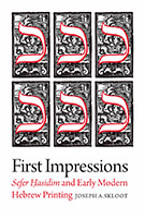First Impressions: Sefer Hasidim and Early Modern Hebrew Printing

Joseph A. Skloot
Uncovers the history of creative adaptation and transformation through a close analysis of Sefer Hasidim
In 1538, a partnership of Jewish silk makers in the city of Bologna published a book entitled Sefer Hasidim, a compendium of rituals, stories, and religious instruction that primarily originated in medieval Franco-Germany. How these men, of Italian and Spanish descent, came to produce a book that would come to shape Ashkenazic culture, and Jewish culture broadly, over the next four centuries is the basis of this kaleidoscopic study of the history of Hebrew printing in the sixteenth century.
During these early years of printing, the classic works of ancient and medieval Hebrew and Jewish literature became widely available to Jewish (and non-Jewish) readers for the first time. Printing, though, was not merely the duplication and distribution of pre-existing manuscripts, it was the creative adaptation and transformation of those manuscripts by printers. Ranging from Catholic Bologna to Protestant Basel to the Jewish heartland of the Polish-Lithuanian Commonwealth, Skloot uncovers the history of that creativity through the prism of Sefer Hasidim in its first two printed editions. Along the way, he demonstrates how volumes, long thought to be eternal and unchanging, were in fact artifacts of historical agency and contingency, created by and for human beings.
PURCHASE FROM Brandeis university PRESS
Expand All
"Who makes a book, the author or the publisher? Joseph Skloot studies a classic of medieval Jewish literature, Sefer Hasidim, to answer this old question in a new way. He takes the reader into two printing houses, one Jewish and one Christian, and shows how each of them framed and transformed the book, giving it an author and sometimes rewriting its text, in their editions. A classic of medieval spirituality that remained labile in manuscript, Sefer Hasidim took on the form it would retain for centuries in the inky hands of correctors. This lively and learned book is a tour de force of book history, rich in textual and human detail." — Anthony T. Grafton, Princeton University
"Recent research has revealed that what we call Sefer Hasidim was composed from a loose collection of a variety of earlier 'treatises' and 'text blocks' without any coherent organization. In this groundbreaking study, Skloot demonstrates convincingly and in detail how this loose collection became a book in the proper sense of the word only during its printing process." — Peter Schäfer, Professor Emeritus, Princeton University
"Skloot’s monograph brings an admirable counterbalance to this broad picture of early Jewish printing. His is a perspective wherein, indeed, the book as the canonical version of the text appears in print but it also accounts for the creativity and consciousness of the bookmakers who actively maneuvered between material, political, and commercial necessities implicit in textual labor." - European Journal of Jewish Studies 18 (2024)
"The deep dive into textual development…reflects the best of what book historical work can offer—namely, the meaning behind the material culture that was so important in early modern intellectual life…Skloot’s ability to explain significance is impressive, and his clear contextualization makes this a worthwhile book for scholars, students, and lay readers of book history, early modern Europe, and Jewish-Christian interaction." - Religious Studies Review
About the Author
Joseph A. Skloot, PhD is the Rabbi Aaron D. Panken Assistant Professor of Modern Jewish Intellectual History at Hebrew Union College-Jewish Institute of Religion. He is a historian of Jewish culture and religious thought.
